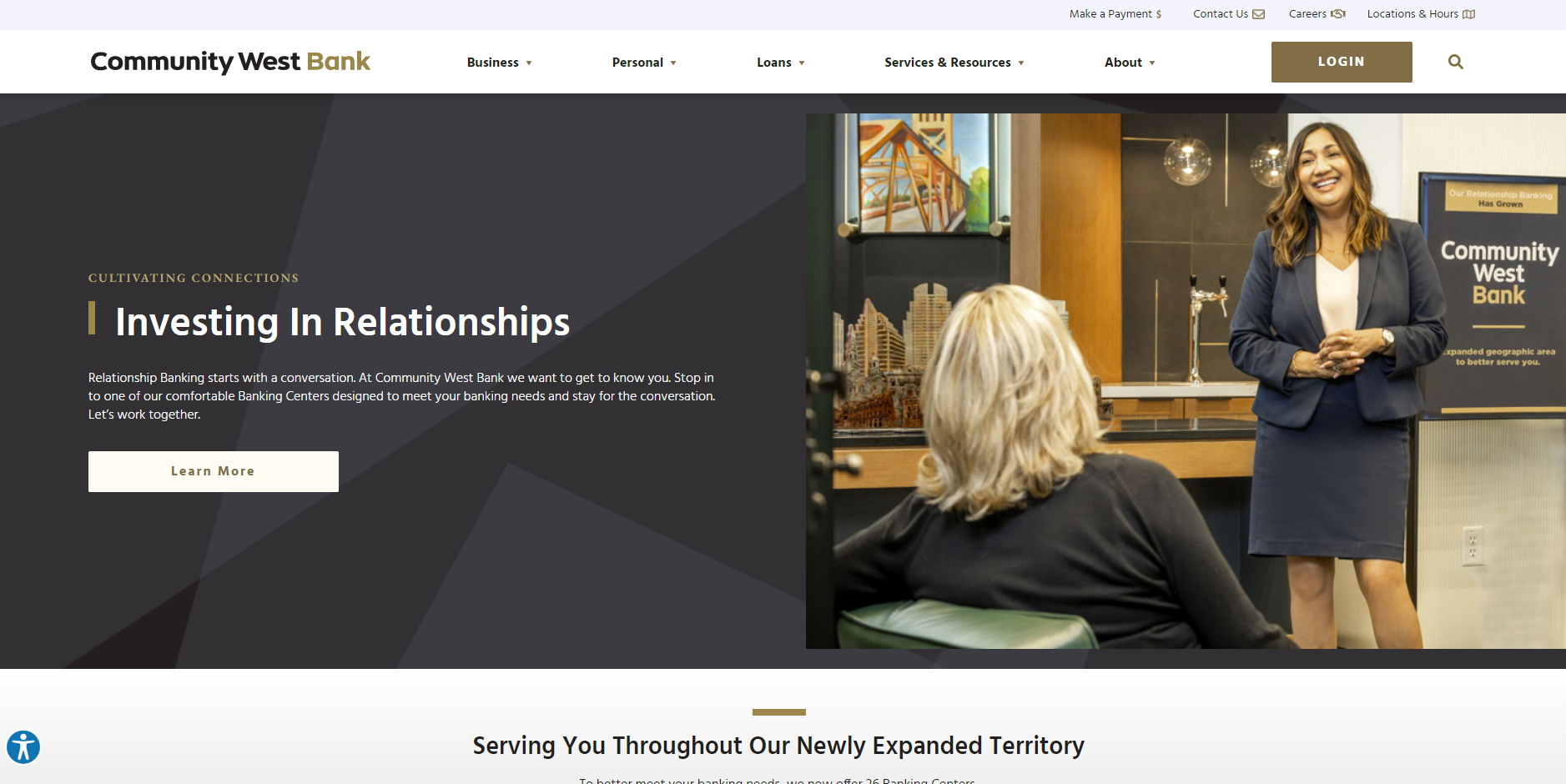Community West Bank
Services we provide:
- Discovery
- Strategy
- UX/UI design
- Website development
- Xperience by Kentico implementation
About Community West Bank
CWB is a large community bank in southern California with over 20+ locations and a track record of financial strength, security and stability gained over its 44 years in business. CWB has set itself apart from other banks by its people, dedication to client advocacy, exemplary "relationship banking," strong community support and a mission to exceed expectations. With a passion for providing customized solutions, the merger drove the decision to revamp their digital services to better serve their customers.
The Process
In an era where digital presence is critical to financial institutions and mergers are frequent, the successful merger of Community West Bank (CWB) and Central Valley Bank (CVB) depended on a robust and well-executed digital strategy, critical to providing a seamless user experience for customers and employees. SilverTech, leveraging its expertise in Xperience by Kentico website development, customized a digital solution that unified the brands of these two banks into one cohesive user-friendly digital experience in just 4 months from start to launch.
The Challenges
The merger of CWB and CVB presented unique challenges, particularly in integrating two distinct digital landscapes into a single cohesive website. The biggest challenges included:
- Differing Content Strategies: CWB's site was optimized for SEO with a rich content library, while CVB's site focused more on detailed product pages. Balancing these different content approaches was crucial.
- Short Timeline: The project needed to be completed with a demanding timeline, delivering a high-quality, functional website, from planning to launch in less than four months.
- Outdated Technology: The old CWB site suffered from poor mobile optimization, slow speeds, outdated information, and a lack of interactive features. This hindered customer engagement and usability.
Goals for New Site
SilverTech identified four main goals for CWB's new website with the main goal of unifying the brands. The merger of the two banks presented a unique opportunity to take advantage of the best from both brands.
Solution and Implementation
Based on the insight gained, SilverTech devised a comprehensive strategy roadmap to address the challenges and deliver a seamless digital experience for the bank merger. It was SilverTech's recommendation that Kentico's newest hybrid CMS platform Xperience by Kentico would be the best solution for the new website. Xperience with robust features and functionality allowed SilverTech to create an exceptional digital user experience efficiently for CWB.
The Key components of the solution include:
- Unified Content Strategy: SilverTech developed a content migration plan that combined the SEO-rich content from CWB with the detailed product information from CVB. This approach ensured that the new site would benefit from both banks' strengths while avoiding duplication and inconsistencies.
- Modern Design and Functionality: The new website was built with Xperience by Kentico, featuring a modern, responsive design to enhance user experience across all devices. Key features included:
- Enhanced Interactivity: Interactive elements and engaging content to improve customer interaction and retention
- Improved CTAs: Clear, strategically placed CTAs to guide users through the site effectively
- Technical Upgrades: Faster loading speeds, improved reliability, and mobile optimization to ensure a smooth user experience
- New Functionalities: Inclusion of essential tools like product comparison tools, branch locator and more
- Accelerated Development Timeline: Despite the tight timeline, SilverTech employed agile development practices to ensure timely delivery without compromising quality. The team worked in sprints to continuously test and refine the site, leading up to a successful launch within the four-month timeframe.
HIGHLIGHTS
HIPAA-Compliant Marketing Solutions You Should Know About
4/9/25
Disclaimer: This blog post is not legal advice. If you would like to ensure you comply with HIPAA guidelines, we encourage you to consult an attorney.
In today’s digital landscape, healthcare organizations rely on their website and marketing analytics to optimize their online presence and improve patient engagement. However, compliance with the Health Insurance Portability and Accountability Act (HIPAA) is crucial when dealing with Protected Health Information (PHI). Many common analytics tools, including Google Analytics, are not inherently HIPAA-compliant. This post explores HIPAA-compliant website analytics solutions, compliant marketing analytics tools, and ways to safeguard Google Analytics to mitigate compliance risks.
Google Analytics is widely used for tracking website traffic and user behavior, but it does not meet HIPAA requirements out of the box. Google does not sign a Business Associate Agreement (BAA) for Google Analytics, which is a critical requirement for HIPAA compliance. And, because Google Analytics collects and stores data, including IP addresses and user interactions, it could inadvertently include PHI.
Due to these factors, healthcare organizations should seek alternative HIPAA-compliant analytics solutions for tracking website and marketing performance.
HIPAA-Compliant Website Analytics Solutions
For healthcare organizations looking to analyze website performance while maintaining HIPAA compliance, the following solutions provide secure alternatives:
- Piwik PRO provides a HIPAA-compliant analytics solution that allows organizations to monitor website traffic while maintaining full control over sensitive data. We’ve listed this option first for a reason – it has become a leader for many healthcare networks for its all-in-one analytics solution that is also reasonably priced compared to the others on the market.
- Siteimprove offers a privacy-first approach to website analytics, ensuring compliance with HIPAA and other regulations such as ADA (Americans with Disabilities Act). It allows healthcare organizations to track user engagement without risking the exposure of PHI. And because it has features around scanning for ADA compliance as well as data insights related to SEO (search engine optimization), it often can serve as a more all-in-one solution for website and marketing analytics. This also means the cost can run higher than other solutions.
- PostHog is an open-source analytics platform with self-hosting options, but it is not inherently HIPAA-compliant unless strict self-hosting configurations are implemented. For healthcare organizations handling PHI, it's necessary that these proper safeguards are put into place. At a base level, PostHog is free but gets pricey as you scale up and pay for the enhanced features needed for HIPAA compliance.
- Freshpaint acts as a bridge between Google Analytics and HIPAA compliance. It ensures that PHI is not sent to Google’s servers by intercepting and processing data before it reaches Google Analytics. This allows organizations to use Google Analytics while maintaining compliance. If internal teams are accustomed to using the Google Analytics platform and prefer to maintain continuity in evaluating data while keeping historical records within a single system, Freshpaint offers the advantage of enabling compliance without requiring a switch to an entirely new analytics solution.
While there are other website analytics solutions, the three mentioned above are the most common. Each one has various advantages and disadvantages such as their overall capabilities, ease of implementation, and cost that your unique organization can weigh depending on your specific needs.
HIPAA-Compliant Marketing Solutions
Beyond website analytics, marketing analytics tools must also comply with HIPAA when handling PHI. The following solutions offer compliant options:
- CallRail provides HIPAA-compliant call tracking and analytics solutions. It helps healthcare organizations measure marketing effectiveness by tracking phone calls without compromising patient privacy.
- Programmatic advertising platforms such as AdTheorent and StackAdapt offer more enhanced solutions for advertising in the healthcare space while maintaining HIPAA compliance. Unlike Google Ads, programmatic vendors can use their predictive advertising platform that ensures compliance with HIPAA by using non-identifiable, privacy-safe data to target healthcare audiences effectively. While most healthcare organizations can still run ads in Google, it is limited (such as the inability to run retargeting campaigns), making your ability to reach the most relevant audience tricky.
Safeguarding Your Website Analytics
Ultimately, we recommend any organization within the healthcare space utilize a HIPAA compliant solution such as the ones mentioned above. However, if any organization, regardless of its industry, chooses to use Google Analytics, there are safeguards you can put in place to help reduce risks and while these alone do not make Google Analytics compliant, they are good practices for organizations that want to safeguard their data.
- By utilizing server-side Google Tag Manager (GTM) implementation, organizations can control and filter data before it is sent to Google Analytics. This prevents the transmission of PHI while still allowing for valuable analytics insights.
- Organizations can also configure settings within their Google Analytics property to exclude or redact any PHI that is inadvertently collected. Consult Google’s support article for more information and instructions for configuring it with your data stream.
- To prevent accidental PHI exposure, organizations should exclude the Google Analytics tracking pixel from firing on potentially sensitive pages, such as location pages or pages containing forms.
Conclusion
Although Google Analytics is a widely used platform for website analytics, it lacks built-in HIPAA compliance. As a result, healthcare organizations should consider alternative solutions that offer more secure and regulatory-compliant marketing data. By prioritizing HIPAA-compliant analytics strategies, healthcare organizations can effectively track and optimize their digital presence while ensuring patient privacy and regulatory compliance.
Unsure what marketing tools and strategies to use or how to implement them? Our experts at SilverTech have worked extensively with our healthcare clients to transform their digital strategies.



